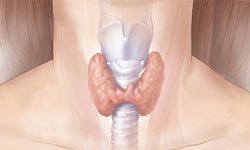Article
Survey Reveals Potential Overuse of Thyroid Nodule Biopsy
Author(s):
A large survey of endocrinologists found wide variation in management strategies for thyroid nodules that were frequently misaligned with current guidelines, particularly for biopsies by fine-needle aspiration.

A large survey of endocrinologists found wide variation in management strategies for thyroid nodules that were frequently misaligned with current guidelines, particularly for biopsies by fine-needle aspiration (FNA), according to findings presented by Nicole O. Vietor, MD, at the 2015 International Thyroid Congress.
In the survey, which was the first to document current management strategies for thyroid nodules, respondents provided feedback on 6 cases, including 5 low-risk nodules and 1 high-risk case. For the high-risk example, which was the only scenario indicated for FNA in most guidelines, 93.8% of respondents said they would use FNA. For the low-risk groups, which were not indicated for FNA, 40.5% said they would conduct the biopsy.
In addition to variations in the use of biopsy, the survey revealed greater utilization of molecular screening of thyroid nodules, particularly in North America, where 73.9% of respondents said they would use routine molecular analysis. In Europe, Asia, and other international locations, molecular analysis utilization dropped to approximately 40%.
"Management of a thyroid nodule is highly variable and differs from societal guidelines in multiple areas," Vietor, of the Walter Reed National Military Medical Center, Bethesda, and colleagues wrote in their abstract. "Regional differences exist with regard to FNA, particularly the use of molecular analysis."
To perform the study, surveys were collected from 897 members of the American Thyroid Association (ATA), American Association of Clinical Endocrinologists (AACE), and The Endocrine Society (TES). Respondents were from North America (63%), Europe (12%), Asia (6.5%), the Middle East/Africa (5.6%), and Oceania (1.9%).
For the use of FNA, respondents were asked whether they would perform the procedure on the following nodules: 1.5-cm hypoechoic nodule (94% said, yes); 0.7-cm hypoechoic nodule with calcifications (67%); 1.4-cm complex-cystic nodule (55%); 1.2-cm isoechoic nodule (42%); 1.8-cm spongiform nodule (37%); or, a 2.5-cm purely cystic nodule (24%).
Consistent with current guidelines, 99.4% of respondents indicated that they would test for thyroid stimulating hormone (TSH). However, vast regional differences were seen for the use of a serum calcitonin assay, which is used to detect C-cell hyperplasia and medullary thyroid cancer.
Several guidelines for the evaluation of thyroid nodules recommend routine serum calcitonin testing; however, the overall utilization in the survey was just 8.4%. Of those surveyed, roughly 32% of European respondents said they would use a serum calcitonin assay compared with just 2.3% of those from North America. For Asia, Latin America, and the Middle East, calcitonin testing rates were 14%, 9%, and 6% respectively.
Approximately half of those surveyed responded that they would perform a thyroid ultrasound, which is advocated for in most guidelines. Ultrasounds were recommended for 83% of FNAs. A 25-gauge needle was selected most commonly (44%) followed by 27-gauge (15%). Approximately a third of respondents did not use any pain reduction methods for the FNA procedure, while some physicians used a topical gel (9%), ice pack (8%), or ethyl chloride spray (8%) to decrease pain.
For follicular lesions of undetermined significance, the majority of respondents (38%) would use molecular analysis, followed by repeated cytology (20%) and lobectomy (20%). For a follicular neoplasm, about 47% would perform a lobectomy with 29% performing molecular analysis and 15% performing a total thyroidectomy. For a suspicious malignancy the results were “much more split,” according to Vietor, with 43% performing total thyroidectomy and another 43% performing lobectomy. Roughly 9.55% would perform molecular analysis.
Cytopathologists were primarily responsible for interpreting FNA results (73%). Assessment of FNA was also frequently performed by a pathologist (18%), a commercial laboratory (8%), or in rare cases, an endocrinologist (1%).
In addition to commenting on each case scenario, respondents were asked about pregnancy issues, for example, whether or not physicians would reconsider performing FNA in a 22-year-old woman at 8 weeks gestation with a 1.5-cm nodule. “Results were split, with 34% stating that they would postpone the procedure and 37% stating they would perform the procedure now,” Vietor explained.
Additionally, to account for age, respondents were asked if they would reconsider performing the FNA procedure on an 82-year-old person with otherwise similar criteria involving no previous history of thyroid disease but a 1.5-cm thyroid nodule. Approximately 64% said they would no longer perform the FNA given the advanced age.
Vietor NO, Burman K, Cooper D, et al. A 2015 survey of endocrinologists on the management of thyroid nodules. Presented at: International Thyroid Congress; October 18-23, 2015; Orlando, FL. Abstract #10.
<<<




















%20(2)%201-Recovered-Recovered-Recovered-Recovered-Recovered-Recovered-Recovered-Recovered-Recovered-Recovered-Recovered-Recovered-Recovered-Recovered-Recovered-Recovered-Recovered.jpg?fit=crop&auto=format)